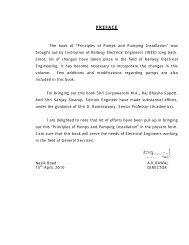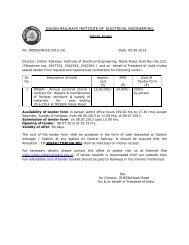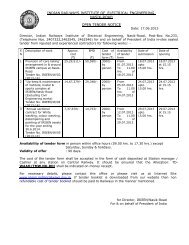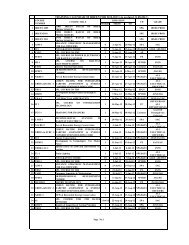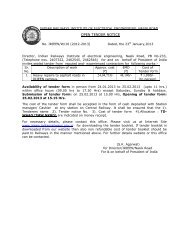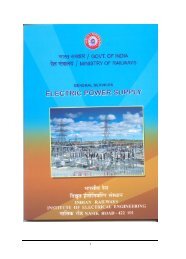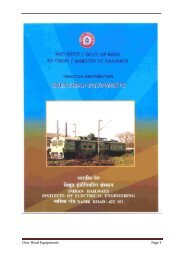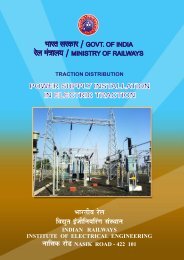Traction Rolling Stock - Indian Railways Institute of Electrical ...
Traction Rolling Stock - Indian Railways Institute of Electrical ...
Traction Rolling Stock - Indian Railways Institute of Electrical ...
You also want an ePaper? Increase the reach of your titles
YUMPU automatically turns print PDFs into web optimized ePapers that Google loves.
9. SAFETY & FIRE PREVENTION<br />
PRECAUTIONS<br />
9.1 FIREFIGIITING APPLIANCES FOR ELECTRIC ROLLING STOCK<br />
Every electric locomotive should be provided either with 2 number <strong>of</strong> 4 kg capacity or 4<br />
numbers <strong>of</strong> 1.25 kg capacity Halon type fire extinguishers to IS 11108, one in each cab and<br />
remaining in each corridor. The fire extinguishers shall be fixed on brackets at approved points in<br />
the cabs and corridors. The ATFR on duty will be responsible for ensuring that the locos leave with<br />
the full complement <strong>of</strong> fire extinguishers. Sufficient number <strong>of</strong> spare fire extinguishers should be<br />
available with the ATFR to replace defective and damaged fire extinguishers.<br />
In exceptional circumstances CEE may authorize change in complement and / or type <strong>of</strong><br />
the fire extinguishers.<br />
On EMU, 2 number <strong>of</strong> 2.5 capacity Halon type fire extinguisher should be provided in<br />
each <strong>of</strong> the cabins occupied by motorman and guard and also 1 number <strong>of</strong> Halon type<br />
extinguisher <strong>of</strong> the same capacity should be provided in each motor-coach <strong>of</strong> EMU. As in the case<br />
<strong>of</strong> other passenger trains, the Operating Department will be responsible for custody <strong>of</strong> the fire<br />
extinguisher and their issue to the guard at the originating station <strong>of</strong> each EMU rake.<br />
All the staff <strong>of</strong> electrical department connected with the running and operation <strong>of</strong> trains<br />
should be duly trained for fire fighting and use <strong>of</strong> fire extinguishers within the locos and EMUs.<br />
9.2 FIRE PREVENTION IN ELECTRIC LOCO<br />
RDSO has issued detailed guidelines for prevention <strong>of</strong> fire on electric locomotives vide<br />
document No.E-21/08/93 issued in June 1993.Important maintenance practices to be followed are<br />
given below:<br />
9.2.1 The presence <strong>of</strong> a large quantity <strong>of</strong> oil in the transformers and tap changers <strong>of</strong> electric<br />
locos and EMUs makes it possible for even minor fires to spread and assume serious proportion.<br />
Spillage <strong>of</strong> oil from exhausters and compressors results in accumulation <strong>of</strong> oil on the loco flooring<br />
causing spread <strong>of</strong> fires. An essential step in prevention <strong>of</strong> fires in locos in therefore, to control the<br />
leakage <strong>of</strong> oil from exhausters, compressors and pipeline and to arrange periodic cleaning <strong>of</strong> the<br />
locos to remove accumulated oil. Always use funnel <strong>of</strong> proper shape for topping <strong>of</strong> oil to prevent<br />
spillage.<br />
9.2.2 The arcing horns <strong>of</strong> contactors should be properly attended to during inspection. The<br />
arc-chute should be properly secured and the securing arrangement periodically checked. The<br />
arc-chute should also be cleaned during inspections.<br />
9.2.3 In addition to periodic cleaning <strong>of</strong> the bogies and under frame to remove oily dust, it is<br />
also important that rheostic and regenerative braking, where provided, is kept in working order and<br />
drivers trained to make use <strong>of</strong> these on graded sections, obviating the need for heavy mechanical<br />
braking as far as possible thus preventing spark from brake blocks.<br />
9.2.4 Rating <strong>of</strong> the fuses particularly <strong>of</strong> low voltage dc circuits are to be checked periodically






